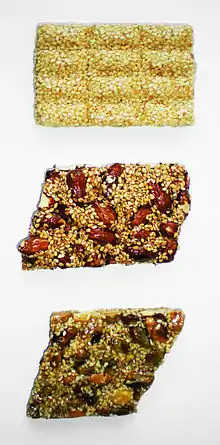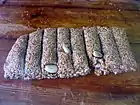Sesame seed candy
Sesame seed candy is a confection of sesame seeds and sugar or honey pressed into a bar or ball. It is popular from the Middle East through South Asia to East Asia. The texture may vary from chewy to crisp. It may also be called sesame (seed) candy/bar/crunch; sesame seed cake may refer to the confection or to a leavened cake or cookie incorporating sesame.
 Three varieties of sesame seed candy. | |
| Type | Confectionery |
|---|---|
| Place of origin | Unknown; possibly Ancient Greece |
| Main ingredients | Sesame seeds, sugar or honey |
- The term "sesame candy" may also refer to sesame halva.
By location
Greece and Cyprus
In Greece and Cyprus, sesame seed candy is called pasteli and is generally a flat, oblong bar made with honey and often including nuts. Though the modern name παστέλι pasteli is of Italian origin,[1] very similar foods are documented in Ancient Greek cuisine: the Cretan koptoplakous (κοπτοπλακοῦς) or gastris (γάστρις) was a layer of ground nuts sandwiched between two layers of sesame crushed with honey.[2] Herodotus also mentions "sweet cakes of sesame and honey", but with no detail.[3]
Indian subcontinent
Various kinds of sesame candy are found in the cuisine of the Indian subcontinent. Sesame Candy in the forms of Rewri/Revri ("candy coated with sesame seeds"), as well as Gajak ("sugar or jaggery sweet with sesame seeds"), is widely eaten in northern India and Pakistan; the cities of Lucknow and Chakwal are very famous for this product.[4] The Assamese tilor laru is an Assamese breakfast snack. The Maharashtran tilgul ladoo is a ball of sesame and sugar flavored with peanuts and cardamom and associated with the festival of Makar Sankranti.
Middle East
Sesame candy is also traditional to northern Iran (Mazandaran province) and is called Peshtezik in Mazandarani and Persian. Peshtezik is usually a thin flat layer of sesame seed with sugar or honey and often includes nuts (specially walnuts). Peshtezik is served in special Persian holidays such as Nowruz and Yalda.
In the Middle East (Jordan, Lebanon, Palestine, Syria), it is called simsimiyah or simismiyeh and is either made as a thin crunchy layer or a slightly thicker chewy candy.
Indochina
In Indonesia, sesame seed candy is known as Ting-Ting Wijen, while the version with peanuts is called Ting-Ting Kacang. These types of candy are influenced by the Chinese.
Europe
In Poland, sesame seed candy is known as sezamki and usually consists only of sesame seeds in thin layers of honey without any nuts.
Gallery
 Puerto Rican sesame seed candy
Puerto Rican sesame seed candy A Greek pasteli
A Greek pasteli
See also
- Joyva, an American manufacturer of Sesame Crunch
- Halva
- List of sesame seed dishes
Notes
- G. Babiniotis, Λεξικό της Νέας Ελληνικής Γλώσσας: "παστέλι."
- Deipnosophists 14:647, discussed by Charles Perry, "The Taste for Layered Bread among the Nomadic Turks and the Central Asian Origins of Baklava", in A Taste of Thyme: Culinary Cultures of the Middle East (ed. Sami Zubaida, Richard Tapper), 1994. ISBN 1-86064-603-4. p. 88.
- Herodotus, Histories 3:48; also in Hist. 3.44: "ἴτρια, τραγήμαθ᾽ ἧκε, πυραμοῦς, ἄμης."
- Gadia, Madhu (2000). New Indian Home Cooking: More Than 100 Delicious Nutritional, and Easy Low-fat Recipes!. Penguin. p. 12. ISBN 978-1-55788-343-8.